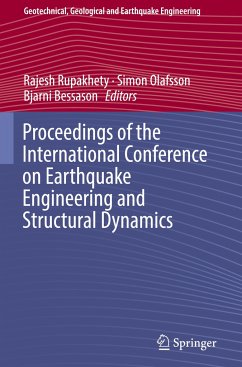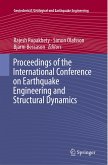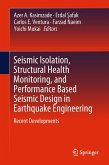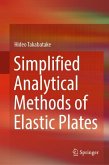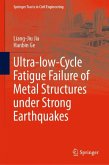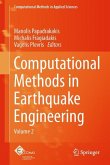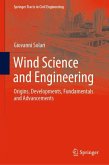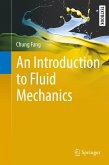Proceedings of the International Conference on Earthquake Engineering and Structural Dynamics
Herausgegeben:Rupakhety, Rajesh; Olafsson, Simon; Bessason, Bjarni
Proceedings of the International Conference on Earthquake Engineering and Structural Dynamics
Herausgegeben:Rupakhety, Rajesh; Olafsson, Simon; Bessason, Bjarni
- Gebundenes Buch
- Merkliste
- Auf die Merkliste
- Bewerten Bewerten
- Teilen
- Produkt teilen
- Produkterinnerung
- Produkterinnerung
This book includes a collection of chapters that were presented at the International Conference on Earthquake Engineering and Structural Dynamics (ICESD), held in Reykjavik, Iceland between 12-14 June 2017. The contributions address a wide spectrum of subjects related to wind engineering, earthquake engineering, and structural dynamics. Dynamic behavior of ultra long span bridges that are discussed in this volume represent one of the most challenging and ambitious contemporary engineering projects. Concepts, principles, and applications of earthquake engineering are presented in chapters…mehr
Andere Kunden interessierten sich auch für
![Proceedings of the International Conference on Earthquake Engineering and Structural Dynamics Proceedings of the International Conference on Earthquake Engineering and Structural Dynamics]() Proceedings of the International Conference on Earthquake Engineering and Structural Dynamics149,99 €
Proceedings of the International Conference on Earthquake Engineering and Structural Dynamics149,99 €![Seismic Isolation, Structural Health Monitoring, and Performance Based Seismic Design in Earthquake Engineering Seismic Isolation, Structural Health Monitoring, and Performance Based Seismic Design in Earthquake Engineering]() Seismic Isolation, Structural Health Monitoring, and Performance Based Seismic Design in Earthquake Engineering119,99 €
Seismic Isolation, Structural Health Monitoring, and Performance Based Seismic Design in Earthquake Engineering119,99 €![Simplified Analytical Methods of Elastic Plates Simplified Analytical Methods of Elastic Plates]() Hideo TakabatakeSimplified Analytical Methods of Elastic Plates104,99 €
Hideo TakabatakeSimplified Analytical Methods of Elastic Plates104,99 €![Ultra-low-Cycle Fatigue Failure of Metal Structures under Strong Earthquakes Ultra-low-Cycle Fatigue Failure of Metal Structures under Strong Earthquakes]() Liang-Jiu JiaUltra-low-Cycle Fatigue Failure of Metal Structures under Strong Earthquakes104,99 €
Liang-Jiu JiaUltra-low-Cycle Fatigue Failure of Metal Structures under Strong Earthquakes104,99 €![Computational Methods in Earthquake Engineering Computational Methods in Earthquake Engineering]() Computational Methods in Earthquake Engineering150,99 €
Computational Methods in Earthquake Engineering150,99 €![Wind Science and Engineering Wind Science and Engineering]() Giovanni SolariWind Science and Engineering172,99 €
Giovanni SolariWind Science and Engineering172,99 €![An Introduction to Fluid Mechanics An Introduction to Fluid Mechanics]() Chung FangAn Introduction to Fluid Mechanics83,99 €
Chung FangAn Introduction to Fluid Mechanics83,99 €-
-
-
This book includes a collection of chapters that were presented at the International Conference on Earthquake Engineering and Structural Dynamics (ICESD), held in Reykjavik, Iceland between 12-14 June 2017. The contributions address a wide spectrum of subjects related to wind engineering, earthquake engineering, and structural dynamics. Dynamic behavior of ultra long span bridges that are discussed in this volume represent one of the most challenging and ambitious contemporary engineering projects. Concepts, principles, and applications of earthquake engineering are presented in chapters addressing various aspects such as ground motion modelling, hazard analysis, structural analysis and identification, design and detailing of structures, risk due to non-structural components, and risk communication and mitigation. The presented chapters represent the state-of-the-art in these fields as well as the most recent developments.
Produktdetails
- Produktdetails
- Geotechnical. Geological and Earthquake Engineering 47
- Verlag: Springer / Springer International Publishing / Springer, Berlin
- Artikelnr. des Verlages: 978-3-319-78186-0
- 1st edition 2019
- Seitenzahl: 524
- Erscheinungstermin: 1. Juli 2018
- Englisch
- Abmessung: 241mm x 160mm x 32mm
- Gewicht: 1004g
- ISBN-13: 9783319781860
- ISBN-10: 3319781863
- Artikelnr.: 51063690
- Herstellerkennzeichnung Die Herstellerinformationen sind derzeit nicht verfügbar.
- Geotechnical. Geological and Earthquake Engineering 47
- Verlag: Springer / Springer International Publishing / Springer, Berlin
- Artikelnr. des Verlages: 978-3-319-78186-0
- 1st edition 2019
- Seitenzahl: 524
- Erscheinungstermin: 1. Juli 2018
- Englisch
- Abmessung: 241mm x 160mm x 32mm
- Gewicht: 1004g
- ISBN-13: 9783319781860
- ISBN-10: 3319781863
- Artikelnr.: 51063690
- Herstellerkennzeichnung Die Herstellerinformationen sind derzeit nicht verfügbar.
Rajesh Rupakhety is a professor at the Civil and Environmental Engineering Faculty at the University of Iceland, and Director of Research at the Earthquake Engineering Research Centre of the University of Iceland. He obtained his BS in Civil Engineering from Tribhuwan University, Nepal, his MSc in Earthquake Engineering and Engineering Seismology from the University of Pavia, Italy and the University of Patras, Greece, and a PhD in Earthquake Engineering from the University of Iceland. Areas of his academic interest are solid and fluid mechanics, structural analysis and design, engineering seismology, and earthquake engineering. Within the fields of solid and fluid mechanics, he has hands on experience in design and construction of hydropower systems. He has professional and research experience in analysis and design of structures for seismic action. In engineering seismology, his research activities include processing of strong motion data, modelling of inelastic response spectra, theoretical and empirical ground motion modelling and prediction, modelling of ground motion random field, quantification of near-fault ground motion, local site effects, and soil amplification. He is also active in use of historical and macroseismic data, probabilistic and deterministic seismic hazard assessment, and seismic hazard assessment for facilities storing hazardous mining waste, and seismic design provisions for hydropower and wind power plants in Iceland. His primary teaching activities are in continuum mechanics, computational mechanics, finite element analysis, structural dynamics, stochastic processes and random vibration, and earthquake engineering. Símon Ólafsson is a research professor and the Director of the Earthquake Engineering Research Centre of the University of Iceland, Selfoss. He received his undergraduate degree in electrical engineering from the same university in 1981 and his MSc degree in electrical engineering from the University of Southern California in 1990. In 1999, he earned his PhD on the dynamics of structures and response to earthquake loading from the Norwegian University of Science and Technology, Trondheim, Norway. During the 1980s, he worked with Professor Ragnar Sigbjörnsson on various instrumentation projects and, most notably, the establishment of the Icelandic Strong Motion Network. His main research interests are engineering seismology and earthquake engineering. His ongoing research projects deal with strong-motion monitoring and signal processing, source mechanics, ground motion modelling using stochastic, discrete time models, earthquake hazard, and system identification. Bjarni Bessason (born 1957), finished a PhD in Earthquake Engineering at the Norwegian Institute of Technology in Trondheim in 1992. He worked from 1991 to 1995 at the Norwegian Geotechnical Institute (NGI) in Oslo and then moved to Iceland where he currently is a Professor in Civil Engineering at University of Iceland. Bjarni has a wide background in structural and earthquake engineering in both research and consulting projects. Main fields of work have been related to: seismic vulnerability analysis; seismic hazard analysis; seismic base isolation; earthquake response analysis; system identification; geophysical characterisation of sites by seismic investigations (SASW, MASW); vibrations from railway, car traffic, pedistrians and blasts; detection analysis of snow avalanches with wave measurements. He is an author/co-author of over 150 scientific papers and technical reports.
1. Seismic Capacity Reduction Factors for a RC Beam and two RC Columns.- 2. Characterization of the wave field around an existing end-supported pontoon bridge from simulated data.- 3. Prediction the Seismic Demands of Tall Buildings Using An Adaptive Force-based Multi-mode Pushover Analysis.- 4. Ambient vibration testing of a 3-storey substandard RC building at different levels of structural seismic damage.- 5. Identification of Rational Functions with a forced vibration technique using random motion histories.- 6. Seismic Design Procedure for Staggered Steel Plate Shear Wall.- 7. Single-Degree-of-Freedom Analytical Predictive Models for Lead-Core Bearing Devices.- 8. Floor spectra for analysis of acceleration-sensitive equipment in buildings.- 9. Finite element model updating of a long span suspension bridge.- 10. Cyclic capacity of dowel connections.- 11. Experimental Study of New Angle Steel Buckling Restrained Braced Restrained.- 12. The Ranges of Uncertainty among the Use ofNGA-West1 and NGA-West 2 Ground Motion Prediction Equations.- 13. Ductile Knee-Braced Frames for Seismic Applications.- 14. Awareness on Seismic Risk: How can Augmented Reality help?.- 15. Seismic Rehabilitation of Masonry Heritage Structures with Base-Isolation and FRP Laminates - A Case Study Comparison.- 16. The Evaluation of Nonlinear Seismic Demands of RC Shear Wall Buildings using a Modified Response Spectrum Analysis Procedure.- 17. Application of MASW in the South Iceland Seismic Zone.- 18. Seismic Fragility Assessment of Reinforced Concrete High-rise Buildings using the Uncoupled Modal Response History Analysis (UMRHA).- 19. Seismic Response Control of Isolated Bridges Including Soil-Structure Interaction.- 20. Damage observations following the Mw 7.8 2016 Kaikoura earthquake.- 21. Performance of base isolated bridges in recent South Iceland earthquakes.- 22. How to survive earthquakes: the example of Norcia.- 23. System Identification of a Residential Building in Kathmandu Using Aftershocks of 2015 Gorkha Earthquake and Triggered Noise Data.- 24. From seismic input to damage scenario: an example for the pilot area of Mt. Etna volcano (Italy) in KnowRISK Project.- 25. Shaping favorable beliefs to seismic protection through risk communication: A pilot-experience in two Lisbon (Portugal) schools.- 26. Between Perception and Knowledge: the construction of the Italian questionnaire to assess the KnowRISK Project actions.- 27. New Design Spectral Acceleration of Soft and Deep Deposits in Bangkok.- 28. The participatory risk communication action of the KnowRISK project: Italy.- 29. Systematic methodology for planning and evaluation of a multi-source geohazard monitoring system. Application of a reusable template.- 30. Development of a common (European) tool to assess earthquake risk communication.- 31. KnowRISK on Seismic Risk Communication: the set-up of a participatory strategy.- 32. The dynamic intelligent bridge: A new concept in bridge dynamics.- 33. Seismicrisk communication: how to assess it? The case of Lisbon pilot-area.- 34. On the manifestation of ground motion model differences on seismic hazard in North Iceland.- 35. Bayesian Heirarchial model of peak ground acceleration for the Icelandic strong-motion arrarys.- 36. Towards an automated Kappa measurement procedure.- 37. Monitoring and Damage Detection of a 70-year-old Suspension Bridge -Ölfusá Bridge in Selfoss, Case Study.- 38. Seismic performance of non-structural elements assessed through shake table tests: The KnowRISK room set-up.- 39. KnowRISK Practical Guide for mitigation of seismic risk due to non-structural components.- 40. A study of rigid blocks rocking against rigid walls.
1. Seismic Capacity Reduction Factors for a RC Beam and two RC Columns.- 2. Characterization of the wave field around an existing end-supported pontoon bridge from simulated data.- 3. Prediction the Seismic Demands of Tall Buildings Using An Adaptive Force-based Multi-mode Pushover Analysis.- 4. Ambient vibration testing of a 3-storey substandard RC building at different levels of structural seismic damage.- 5. Identification of Rational Functions with a forced vibration technique using random motion histories.- 6. Seismic Design Procedure for Staggered Steel Plate Shear Wall.- 7. Single-Degree-of-Freedom Analytical Predictive Models for Lead-Core Bearing Devices.- 8. Floor spectra for analysis of acceleration-sensitive equipment in buildings.- 9. Finite element model updating of a long span suspension bridge.- 10. Cyclic capacity of dowel connections.- 11. Experimental Study of New Angle Steel Buckling Restrained Braced Restrained.- 12. The Ranges of Uncertainty among the Use ofNGA-West1 and NGA-West 2 Ground Motion Prediction Equations.- 13. Ductile Knee-Braced Frames for Seismic Applications.- 14. Awareness on Seismic Risk: How can Augmented Reality help?.- 15. Seismic Rehabilitation of Masonry Heritage Structures with Base-Isolation and FRP Laminates - A Case Study Comparison.- 16. The Evaluation of Nonlinear Seismic Demands of RC Shear Wall Buildings using a Modified Response Spectrum Analysis Procedure.- 17. Application of MASW in the South Iceland Seismic Zone.- 18. Seismic Fragility Assessment of Reinforced Concrete High-rise Buildings using the Uncoupled Modal Response History Analysis (UMRHA).- 19. Seismic Response Control of Isolated Bridges Including Soil-Structure Interaction.- 20. Damage observations following the Mw 7.8 2016 Kaikoura earthquake.- 21. Performance of base isolated bridges in recent South Iceland earthquakes.- 22. How to survive earthquakes: the example of Norcia.- 23. System Identification of a Residential Building in Kathmandu Using Aftershocks of 2015 Gorkha Earthquake and Triggered Noise Data.- 24. From seismic input to damage scenario: an example for the pilot area of Mt. Etna volcano (Italy) in KnowRISK Project.- 25. Shaping favorable beliefs to seismic protection through risk communication: A pilot-experience in two Lisbon (Portugal) schools.- 26. Between Perception and Knowledge: the construction of the Italian questionnaire to assess the KnowRISK Project actions.- 27. New Design Spectral Acceleration of Soft and Deep Deposits in Bangkok.- 28. The participatory risk communication action of the KnowRISK project: Italy.- 29. Systematic methodology for planning and evaluation of a multi-source geohazard monitoring system. Application of a reusable template.- 30. Development of a common (European) tool to assess earthquake risk communication.- 31. KnowRISK on Seismic Risk Communication: the set-up of a participatory strategy.- 32. The dynamic intelligent bridge: A new concept in bridge dynamics.- 33. Seismicrisk communication: how to assess it? The case of Lisbon pilot-area.- 34. On the manifestation of ground motion model differences on seismic hazard in North Iceland.- 35. Bayesian Heirarchial model of peak ground acceleration for the Icelandic strong-motion arrarys.- 36. Towards an automated Kappa measurement procedure.- 37. Monitoring and Damage Detection of a 70-year-old Suspension Bridge -Ölfusá Bridge in Selfoss, Case Study.- 38. Seismic performance of non-structural elements assessed through shake table tests: The KnowRISK room set-up.- 39. KnowRISK Practical Guide for mitigation of seismic risk due to non-structural components.- 40. A study of rigid blocks rocking against rigid walls.

